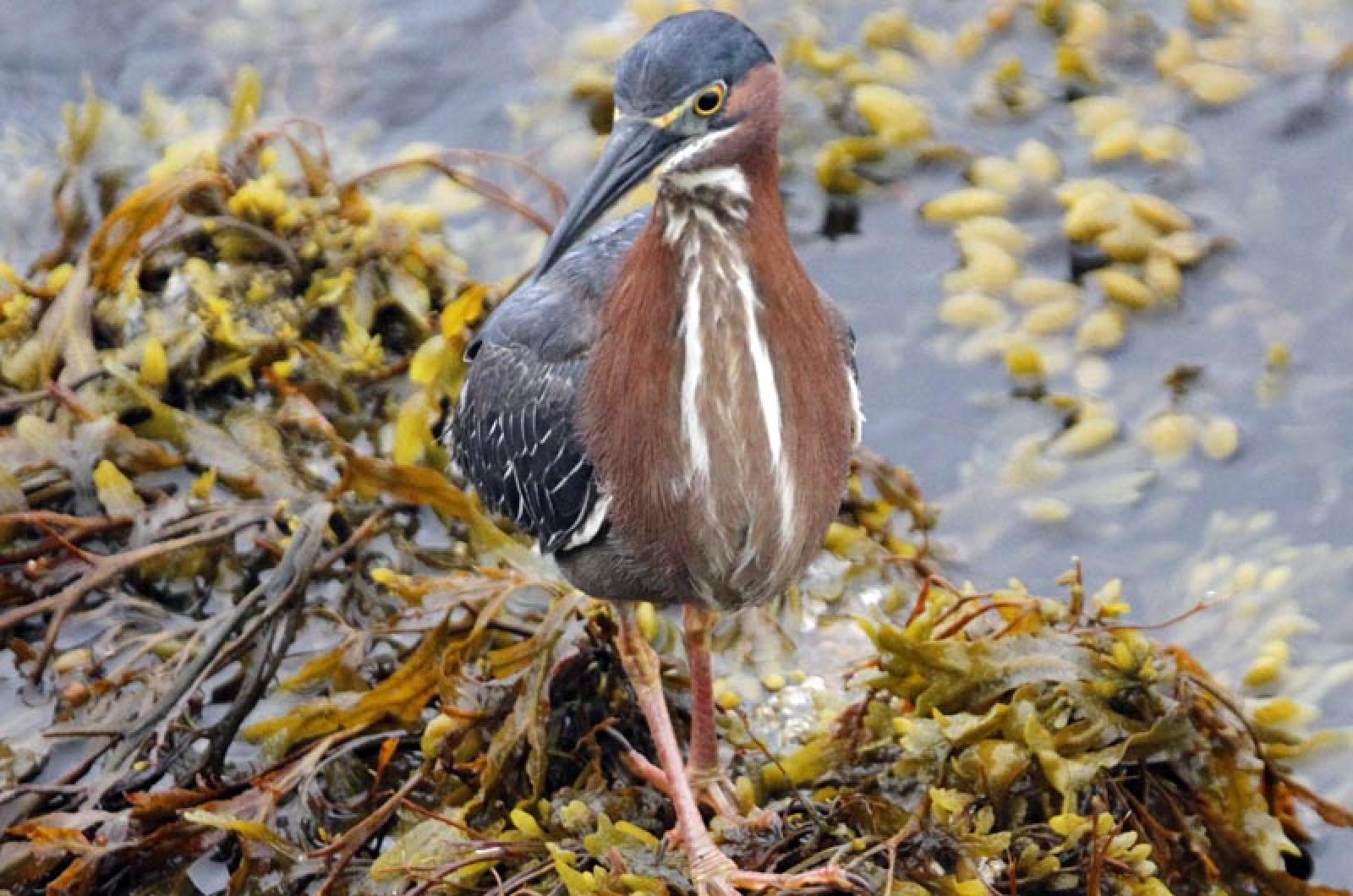What is a small heron that slowly and methodically moves along the marshes, sandy beaches and rocks, hunting fish, insect larva, shrimp, crabs and other creatures of ponds and oceans? A bird that makes a habit of crouching as it waits for dinner or that moves like a cat, placing one foot gently down and then the other? The same bird has been called “stand and wait.” Done waiting, this heron stabs into the water with incredible speed and captures a meal. We know it as green heron or little green heron. In other parts of the country the green heron has names such as fly up the creek, crab-catcher, poke, swamp squaggin and skeow. The last two names were obviously given this heron because it describes the sound the bird makes when it is startled.
A startled green heron is very elegant. He raises a crest on his greenish head (the only part of the green heron that can be considered somewhat green) and stretches its neck so we can see the white streaks on its chestnut chest and its white belly and rump.
The green heron nests back from the water in the woods but have been known to make their nests on top of a muskrat house. Both parents incubate the nest of four or five pale green or blue-green eggs for 19 to 21 days. The young fledge 21 to 23 days after hatching and are fed by their parents until they migrate south, in the case of the Vineyard green herons.
The green heron is found on the Atlantic, Gulf and Pacific coasts of the United States, and inland as far as the Mississippi River. It is not found in the western states, except coastal or riverine habitats. Winter finds green herons down into Central America and Puerto Rico.
Recent sightings of green herons on the Vineyard include the following: Iya Labunka watched a green heron hunting around the Menemesha docks on June 10. Morgan Donn spotted two green herons on the Menemsha breakwater, as well as an American oystercatcher on June 12. Natalie Woodruff sent in several photographs of a green heron she spotted in the marsh at the northeast end of the Lagoon on June 16. Matt Pelikan noted that he often finds green herons fishing from the rip rap along the Vineyard Haven harbor between the bridge and Five Corners.
Bird Sightings
A report from Biodiversity Works let me know that three out of the four willets that were fitted with geo tags in 2013 are back on-Island. Three of the 2013 willets were tagged on Chappaquiddick and one on Little Beach in Edgartown. Presently the team from Biodiversity Works, plus biologist Joe Smith, are trying to recapture these 2013 tagged willets to read the data collected during the winter months when they were off-Island. The data will show not only where these willets spent the winter but also at what altitude they migrated to and from the wintering grounds. Unfortunately, the willets’ first nests haven’t lasted long enough for the team to capture them due to crow and other creature predation. Biodiversity Works has, however, placed geo tags on three new willets; two on Chappaquiddick and one at Little Beach this last month.
While surveying willet, piping plover, tern and American oystercatcher nests, Luanne found some Virginia rails on Chappaquiddick, and also two active belted kingfisher nests; one on Sengekontacket Pond and one near Cedar Tree Neck.
On a negative note, piping plover, American oystercatchers and least tern colonies around Chilmark Pond have been disturbed by what appears to have been horseback riders. Please, whether you have a dog, cat, horse or other creature, please make sure they stay outside the roped-in areas on the Vineyard’s barrier beach!
Martha Moore’s report last week of the failed osprey nest at Middlepoint Cove on Tisbury Great Pond peaked Dick Jenning’s curiosity. Dick had checked that nest in early May and noted that it was not active. Martha Moore, an excellent record keeper, has notes from many years on the activity of that osprey nest. She noted that the pair of ospreys did not start their nesting activities until May 15 this year. That is late, according to Dick. The birds paired and were on eggs almost a month before the weather probably caused the failure. The total number of pairs of osprey on the Vineyard in 2014 is an all-time high of 81.
Whippoorwills have been reported from two areas in Aquinnah. John and Jan Wightman heard one on June 10, and Randy Donn heard whippoorwills on both June 11 and 12. Karen Mead and her son Morgan Donn sent good reports of the activity around Aquinnah. They spotted two adult piping plovers with four young near Zack's Cliffs on June 9.
Tom Rivers was pleased to see a fairly rare bird on the Vineyard on June 12; a black vulture in with five turkey vultures, all playing in the thermals above his Tea Lane, Chilmark home.
Glenda Hazard of East Chop sent a photo of a bird she wanted identified. It appears to be the leucistic song sparrow that has been visiting the Crystal Lake, East Chop, area for the past few years.
Please report your bird sightings to birds@mvgazette.com.
Susan B. Whiting is the co-author of Vineyard Birds and Vineyard Birds II. Her website is vineyardbirds2.com.





Comments
Comment policy »